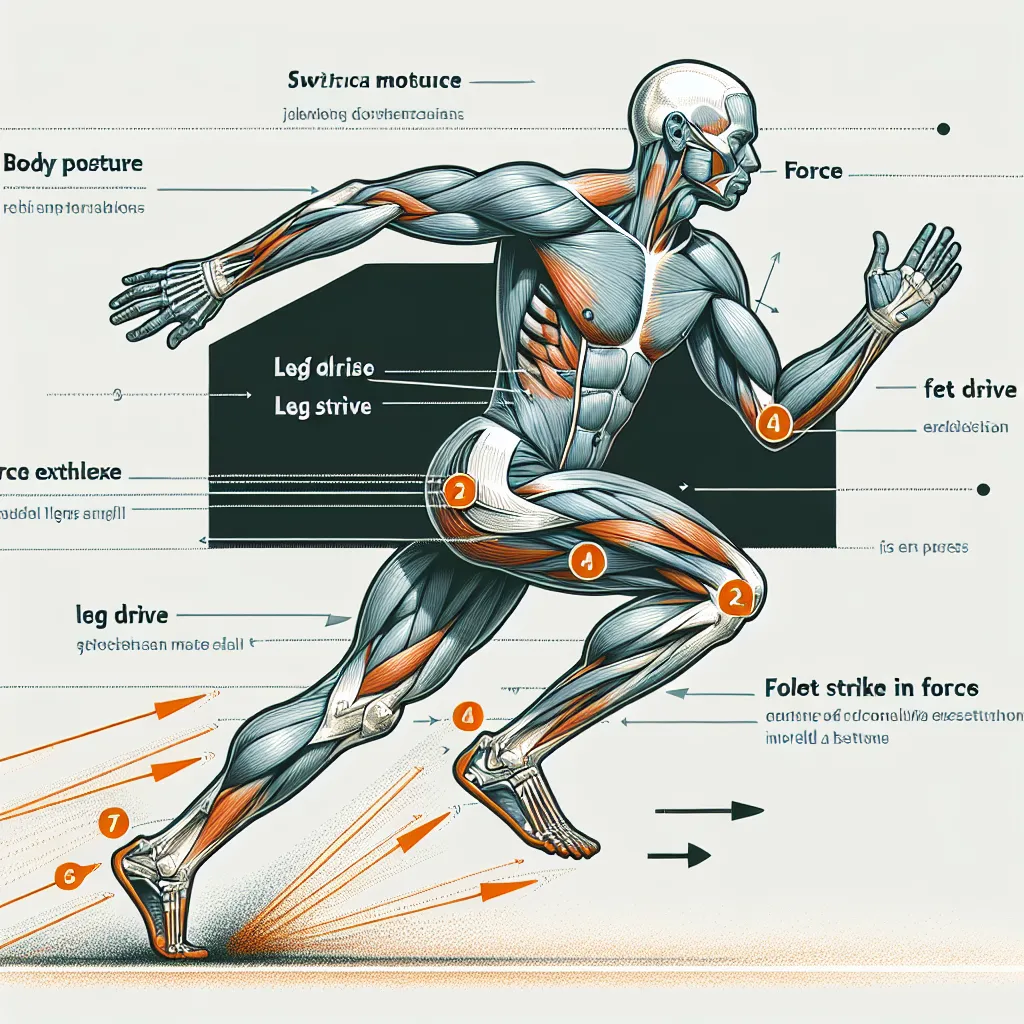Sprint mechanics is a crucial concept in sports science and athletics, particularly relevant for IELTS test-takers aiming to excel in sports-related topics. Let’s dive into this term, its usage, and how to effectively incorporate it into your IELTS preparation.
Understanding ‘Sprint Mechanics’
Definition: Sprint mechanics refers to the technical aspects and biomechanical principles involved in sprinting, including body positioning, arm and leg movements, and overall efficiency of motion during high-speed running.
Part of Speech: Noun phrase
Pronunciation: /sprɪnt mɪˈkænɪks/

Context and Usage of ‘Sprint Mechanics’
Examples in Context
-
Proper sprint mechanics can significantly improve an athlete’s performance on the track.
Analysis: This sentence highlights the importance of sprint mechanics in athletic performance, emphasizing its direct impact on speed and efficiency. -
The coach focused on refining the team’s sprint mechanics through specialized drills and exercises.
Analysis: Here, we see the practical application of sprint mechanics in training, suggesting it’s a skill that can be developed and improved. -
Researchers are using advanced motion capture technology to analyze sprint mechanics in elite runners.
Analysis: This example demonstrates the scientific approach to studying sprint mechanics, indicating its relevance in sports science and research. -
Improving your sprint mechanics can lead to faster times and reduced risk of injury.
Analysis: This sentence connects sprint mechanics to both performance enhancement and injury prevention, showing its comprehensive benefits. -
The biomechanist explained how subtle changes in sprint mechanics could lead to significant improvements in race times.
Analysis: This example illustrates the precision and detail involved in sprint mechanics, emphasizing how small adjustments can have substantial effects.
Common Contexts
Sprint mechanics is frequently discussed in:
- Athletic training programs
- Sports science research papers
- Biomechanics lectures
- Track and field coaching sessions
- Physical therapy for runners
Frequency in IELTS
While not extremely common, ‘sprint mechanics’ may appear in IELTS Reading passages related to sports science or in Writing Task 2 essays discussing athletic performance. It’s less likely to be directly tested in the Listening or Speaking sections but could be relevant in discussions about sports or fitness.
Vocabulary Analysis
Word Structure
- Sprint: A fast run over a short distance
- Mechanics: The branch of physics dealing with motion and forces producing motion
Synonyms and Antonyms
Synonyms:
-
Running technique (noun phrase)
Pronunciation: /ˈrʌnɪŋ tɛkˈniːk/
Definition: The method or style of running, especially in terms of efficiency and speed. -
Sprinting form (noun phrase)
Pronunciation: /ˈsprɪntɪŋ fɔːm/
Definition: The posture and movement pattern adopted during high-speed running. -
Locomotor biomechanics (noun phrase)
Pronunciation: /ˌləʊkəˈməʊtə ˌbaɪəʊmɪˈkænɪks/
Definition: The study of the mechanical aspects of body movement during running or sprinting.
Antonyms:
-
Static posture (noun phrase)
Pronunciation: /ˈstætɪk ˈpɒstʃə/
Definition: The alignment and positioning of body parts when not in motion. -
Endurance running technique (noun phrase)
Pronunciation: /ɪnˈdjʊərəns ˈrʌnɪŋ tɛkˈniːk/
Definition: The method or style of running optimized for long-distance performance rather than speed.
Memorization Techniques
Mind Map
Create a mind map with ‘Sprint Mechanics’ at the center, branching out to key components:
- Body Posture
- Arm Action
- Leg Drive
- Foot Strike
- Energy Transfer
- Acceleration Phase
- Top Speed Phase
Visualization Technique
Imagine yourself as a top sprinter at the Olympics. Picture each phase of your sprint, from the starting blocks to crossing the finish line. Visualize the perfect form: leaning slightly forward, powerful arm swings, high knee lift, and explosive foot strikes. This mental image can help embed the concept of sprint mechanics in your memory.
Practice Exercises
-
Write a paragraph describing the importance of sprint mechanics in athletic performance. Use at least three related terms from the mind map.
-
Compare and contrast sprint mechanics with endurance running techniques in a short essay. Consider aspects such as energy expenditure, muscle engagement, and body positioning.
-
Analyze a video of a professional sprinter and describe their sprint mechanics using appropriate terminology. Focus on different phases of the sprint and specific body movements.
-
Create a training plan for improving sprint mechanics, including specific exercises and drills. Explain how each activity contributes to overall sprinting efficiency.
-
Discuss how technology has impacted the study and improvement of sprint mechanics in modern athletics. Consider aspects such as motion capture, force plate analysis, and high-speed video recording.
Conclusion
Mastering the concept and vocabulary of ‘sprint mechanics’ can significantly enhance your ability to discuss sports-related topics in the IELTS exam. By understanding its components, practicing usage in various contexts, and applying memorization techniques, you’ll be well-equipped to incorporate this term effectively in your test responses.
Remember, the key to retaining new vocabulary is regular practice and application. Try to use ‘sprint mechanics’ and related terms in your English conversations, writing practice, and IELTS preparation exercises. This active engagement will help solidify your understanding and improve your overall performance in the exam.
We encourage you to share your experiences with learning and using this term in the comments section below. How has understanding sprint mechanics enhanced your IELTS preparation? Do you have any questions about applying this concept in different parts of the IELTS test? Your insights and queries can help fellow learners and contribute to a more comprehensive understanding of this topic.